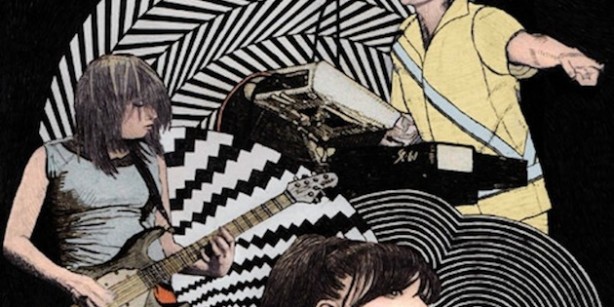 Music
Music
Director Kerthy Fix on the new Le Tigre tour doc and how they "made feminism cool again"
by Nicole Villeneuve
May 2, 2011
Throughout 2004 and 2005, a crew member on tour with feminist electro-punks Le Tigre captured about 45 hours of footage, documenting the band both on and off-stage as they brought their colourful, sociopolitical dance party around the world.
From their start in 1998 until their last album, the major-label, Billboard-charting This Island, released in 2004, Le Tigre continued the work Hanna had become known for in riot grrrl kingpin band Bikini Kill—confronting sexism and championing human rights, in the process becoming the figureheads for a community that again finds itself in the midst of a surge, thanks no doubt in part to Hanna’s emergence as an intelligent public figure (she recently donated her personal archives of zines, correspondence, and other writings to NYU’s library as part of their Riot Grrrl collection).
After years of the Le Tigre footage sitting untouched, a meeting through mutual friends of the band’s iconic singer Kathleen Hanna and film director Kerthy Fix meant it would, in perfect timing, finally see the light of day. After reviewing the footage, Fix would create a film for a fan-only DVD, and set about completing a series of supplementary interviews with band members Hanna, Johanna Fateman, and JD Samson. It was here that the film evolved from a rather shapeless fan film into a band and tour documentary.
Who Took The Bomp: Le Tigre on Tour is a timely tribute to a band that transformed minds and lives, setting forth ideas and defining ideals for a new generation. For its international premiere at Toronto’s Hot Docs Film Festival, AUX spoke with directory Kerthy Fix about the making of the film and the legacy of Le Tigre.
Who Took the Bomp: Le Tigre on Tour screens Wednesday, May 4 at 7 p.m. (The Royal Cinema), Thursday, May 5 at 11:45 p.m. (Bloor Cinema), and Friday, May 6 at 9:30 p.m. (TIFF Bell Lightbox).
AUX: The footage for the film was shot a few years ago on tour, and it was later handed to you to put together. I’m curious how you got involved in the film?
Kerthy Fix, Director: Kathleen [Hanna] was on a panel with Courtney Martin who is an author and one of the experts in a film I co-produced called Who Does She Think She Is? They were talking about possible documentary directors who could pull together a film, and Courtney thought of me. Kathleen and I met and after meeting Jo [Fateman] and JD [Samson] and looking at the footage, we decided to cut together something that would work as a fan DVD.
What were the challenges working with someone else’s footage and initial idea? Or, was there a challenge to create your own ‘idea’ for the film out of just footage?
Carmine Covelli had shot about 45 hours on Le Tigre’s year long world tour and did a great job of capturing the fun, playful side of the band, but his primary role on tour was lighting director for the live show so he didn’t have the luxury of concentrating solely on being a documentarian. I shoot a lot of my own footage so conceptually, I approached the footage as “archival” (which in a sense it was since it had been shot 5 years earlier). This made me treat the material with a lot of gratefulness because it is a goldmine of humor and intimate moments. But I also knew I wanted to shoot interviews with Jo, JD and Kathleen so that the viewer would have another layer of insight into what they were feeling and thinking at the time. We were surprised to discover that once Sarah Devorkin, one of the editors, dropped in the interviews, the cut then read as a “film” film. We were operating under the premise that we were making a DVD just for fans at this point. A film for fans doesn’t have to meet the same narrative requirements that a doc for a general audience might have to. So, we found that Le Tigre’s political and social importance really popped once we heard them reflecting on the legacy of the band in the present-day interviews. We screened privately for a few doc editors who varied in their knowledge of the band and they told us they loved the characters, loved the music, and suddenly we were in different territory. Once your building a film for a general audience rather than a niche group of insiders, you have to explain things like Riot Grrrl or what a big rock festival is like. We screened this new more substantial cut with the band and they agreed that we needed to take the film in this direction. Once we screened with another group of about 20 friends and advisers, we realized that we had a concert film with lots of great scenes and that it should be on the festival circuit.
Was it a natural inclination to make the film a little lighter than some drama-fueled tour/band films?
In making a film, you have to react to the material that exists. Unlike Strange Powers, my first film about the songwriter Stephin Merritt [Magnetic Fields], Le Tigre is fast-talking, improvisational and high energy. Their sense of humor as reflected in the behind-the-scenes footage was really funny. They have a deep bond with each other as friends and as artists. The music is upbeat and danceable and they are consciously using a zine approach to the digital music-making tools. So a film about them had to reflect this. It had to be smart, incisive and humorous—move fast and make people laugh. I have been surprised at how moved people have been at seeing Le Tigre historcised in this film. That Le Tigre’s work is a profound confirmation of how to be a good human.
It’s exciting for the film to be released a few years after the time it captured and see people excited about it. What’s your take on the band and their relevance/influence now, on a new generation?
It’s actually sent me into deep reflection on the period of the 90’s and its larger historical and social significance. Because Kathleen Hanna and Le Tigre were so important to the era, fans in their 30’s who were influenced by Le Tigre now come to the film with a need to have those values reinforced. I think it’s because we want to understand the history of these artists and these alternative communities because it can model a way of living in the present that has meaning, that creates social change through how one lives one’s life. This is demonstrated in the current interest in eating locavore, making one’s own food, farmer’s markets, crafting etc that has exploded in the last years. I’ve been re-visiting my Angry Women (research) book and remembering how much it was a bible for the 90’s feminist. These are the cultural documents that act as life rafts for the freaks, queers, feminists, and eccentrics who don’t have a community by virtue of where they were born or what family they were raised in. They function to let the 17 year old whose getting gay-bashed or the guy who doesn’t want to become his sexist, racist father, or the woman who wants to be a weirdo artist. It lets them know that there’s a wider world out there for them. By functioning in the pop world, Le Tigre made feminism cool again. Their subversion was in the joy and humor and grace with which they did it. They took the rage of the 90’s and translated it into a passion for living. The fact that this was a gateway drug to younger audiences for progressive politics, queer politics and feminism can’t be underestimated. And lordy, how they made us dance.
Tags: Music, Interviews, hot docs, Interviews, Le Tigre





